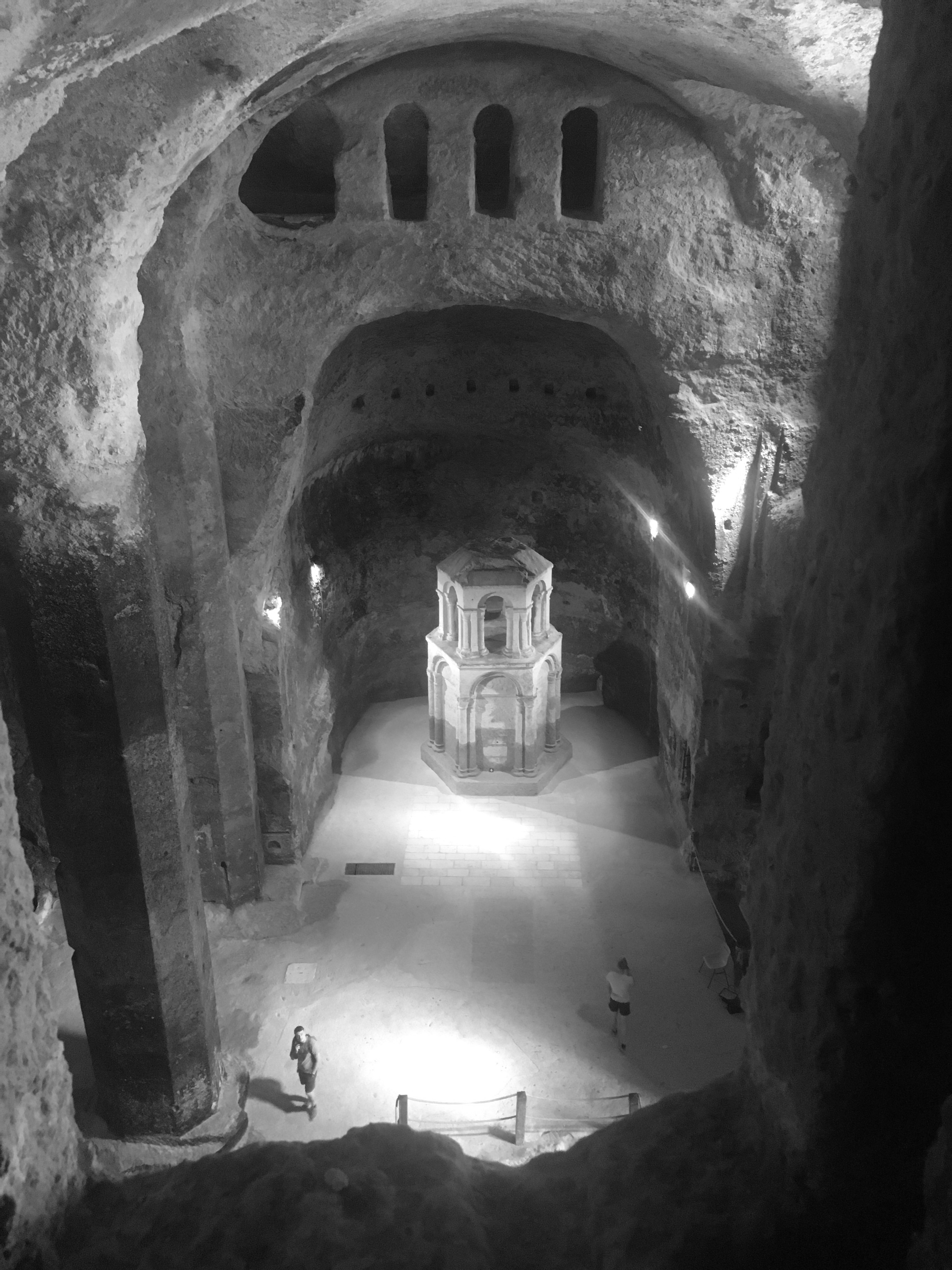Aubeterre
Contributor
Reading the Room
The first I heard of Aubeterre it was June in the Charente, and we could sit out late as nine or ten in the evening, watching the pink light hover over the fields. Eric, who had come to France for a few days, was telling us that if hay bales get wet and then dry, they can explode. He had seen it happen. At the end of the table, Pascal said to Seamus, beside me, that there was a cathedral built into the side of a cliff at the top of the Dordogne. We should go, he said, before Seamus leaves for Ireland. Seamus shakes his head. He doubts the Citroën can get that far. But every afternoon we take it out and drive for hours through empty villages, the quiet shuttered fields.
We go, a few days later, coaxing the Citroën along, to see L’Eglise de St. Pierre, the cathedral carved out of the stone face of the white cliff. It’s a two-hour drive. As we go, I read aloud: work was begun on the church in the fourth century; it was completed in the twelfth century. The ceiling is among the highest in Europe. Over time, vegetation grew and covered it until by the eighteenth century the church had disappeared from view. Vanished. Forty years ago, I read, two trucks collided with such force that they fell through the paved road and down into the crypt. And there was the cathedral, huge, buried alive. Un étonnement! says the guidebook. An astonishment.
At noon, the heat is intense. We manage to park the car on a side street, and follow painted signs to the entrance of the cathedral, which we find at the end of a wooden walkway. The ticket table is attended by a boy of about thirteen. We are the third and fourth visitors today, he says. Is that usual?, I ask. He shrugs. We pass under the high arched door into unfathomable green gloom. To the right, the fretwork of countless tombs, declivities in the stone floor, are the shape a sleeping body takes. Above, the ceiling devolves into darkness, the stone walls wet to the touch and green with moss. In the center of the cavern is a Romanesque reliquary, twenty feet high, based on the Holy Sepulcher in Jerusalem. The reliquary chapel has a peculiar glow in the green darkness, its slim columns and architraves soaring upwards, a captive unicorn.
It is impossible—the vision is too searing, too immense to comprehend—to see the church at one go. We emerge from the ark of the dead into the hot sunshine and have lunch at a restaurant across the way, a not very good lunch, but we were hungry, and the bougainvillea was pretty. Then we return, walking down to the crypt, holding a rope handrail to keep from slipping on the slick steps. Underground, we stand close together, but it is impossible to look at each other, it is at once too dark, and too shaming, as if we were affronting the dead in our light summer clothes, the sun warm on our skin, and after a few minutes we go out into the bright afternoon, and the church becomes a momentary shared dream—a dream, that for the village, went on for centuries. And for us? “They bear no relation to anything dreamt or seen,” said Forster, of the Marabar Caves. But something has happened. In the car, we barely speak.
On the way back to Lussac, the route, which had evaded us on the way to Aubeterre, unfolds straight ahead, to La Couronne, past La Rochefoucauld, and on to Chasseneuil. Seamus’s profile is bleached against the fields as the Citroën makes its way west. From the north, a smell of burning. The sky above the trees turns violet streaked with green. To the east, the shimmering void of the church at Aubeterre, a great dark green space; an underground mirror of the sky. Virginia Woolf wrote, about Forster, “His concern is with the private life; his message is addressed to the soul: it is the private life that holds out the mirror to infinity.” Before I came to France, that look of remoteness came over you and I once again wanted to be anywhere else, anywhere else at all, to walk into an empty room.
When you first read these pages, a long essay of which these paragraphs are an excerpt, you said, but the church must be moved to the center. It is the kind of thing you like, a burrow under the earth, a space that opens, opens and opens. Here it is then, a few lines on a page, sketching an emptiness, excavated over eight hundred years by farmers, masons, monks. Hidden until two trucks collided, and the past emerged from its dream. As now in these past weeks, a collision between the past and the future has opened, and grieved and astonished we have fallen into the last century, lined with trenches stacked with the dead. How can we read the place and time in which we find ourselves?

Cynthia Zarin is a Senior Lecturer in English at Yale. Her most recent book is Two Cities, a collection of essays on Venice and Rome; a novel, Inverno, and Next Day, New and Selected Poems will be published next year.